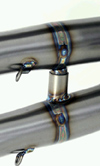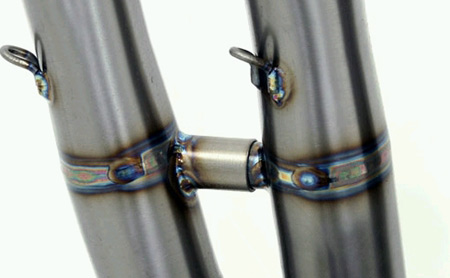World Superbike exhausts
 World Superbike remains a popular series in motorcycle racing, its enduring appeal stemming from the fact that the machines are based on the same motorcycles that you can find in your local showroom. Twenty years ago, it was a competition full of limited-production homologation machines, such as the Honda RC30 and Yamaha OW-01, which were produced at great expense and which required a racing kit that at the time dwarfed the cost of the motorcycle. In 1990, if we discount the Bimota machine, the most expensive road bike was the Yamaha OW-01 at £12,700 ($21,000-24,000 during that year). The race kit suspension alone would double the cost of the motorcycle, even before adding the cost of the kit engine internals, exhaust and so on.
World Superbike remains a popular series in motorcycle racing, its enduring appeal stemming from the fact that the machines are based on the same motorcycles that you can find in your local showroom. Twenty years ago, it was a competition full of limited-production homologation machines, such as the Honda RC30 and Yamaha OW-01, which were produced at great expense and which required a racing kit that at the time dwarfed the cost of the motorcycle. In 1990, if we discount the Bimota machine, the most expensive road bike was the Yamaha OW-01 at £12,700 ($21,000-24,000 during that year). The race kit suspension alone would double the cost of the motorcycle, even before adding the cost of the kit engine internals, exhaust and so on.
The racing kit, which was seen as being necessary to be competitive, was supplied by the factory, and often included a 'kit' exhaust. Today, the road-going motorcycles on which the racers are based are, in general, much more reasonably priced, and it is much more likely that the bikes will have a race kit that includes parts made in partnership with technical experts outside the company. It is now rare, even for the factory-supported teams, to have an unbadged 'works' exhaust.
It is also common for individual teams to have development projects running with an exhaust manufacturer. This model of independent exhaust development - either in conjunction with a manufacturer or an individual team - is a real boon for the exhaust makers, with race fans being able to buy similar products for their road-going machinery. The teams benefit from an independent source of development, which can be carried out at a reduced rate because there is a source of income derived from sales.
The exhaust systems used vary in design according to the machinery used. Yamaha and Suzuki both race with inline four-cylinder engines, but these have different firing orders. The Yamaha, in common with the MotoGP engine, uses a cruciform crankshaft rather than the more traditional flat-plane design.
This crankshaft configuration is discussed in Ian Cramp's recent RET-Monitor article. The system used by Yamaha is a basic 4-2-1 configuration, but after the final collector, the pipe splits into two before the under-seat exit, so it can be said to be a 4-2-1-2. The primary pipes are of a tapered header design and are linked in pairs, with cylinders one and two joined and cylinders three and four joined. The company producing the systems is known for its hydroforming technology, and this is likely to be used on the Superbike systems.

The Suzuki uses a conventional flat-plane crankshaft, but still joins the same pairs of primary pipes together, as does the cruciform Yamaha, and again splits into two silencers, but which exit at the sides of the bike. The Kawasaki again pairs the same cylinders in its exhaust system. However, some of the inline four-cylinder systems also use link pipes between adjacent primaries to help tune the exhaust system to work at certain speeds.
The Aprilia, being a V4, is more limited in scope for joining different pipes together; predictably this machine runs cylinders paired as per the architecture of the engine, with the two secondary pipes joining into a single collector before the silencer.
Fig. 1 - Link pipes on exhaust systems developed in World Superbike competition
Written by Wayne Ward